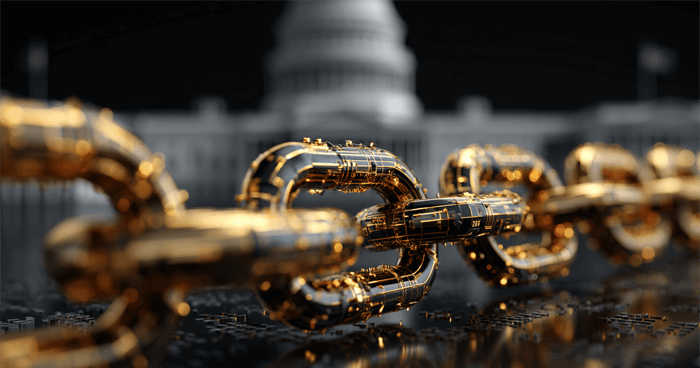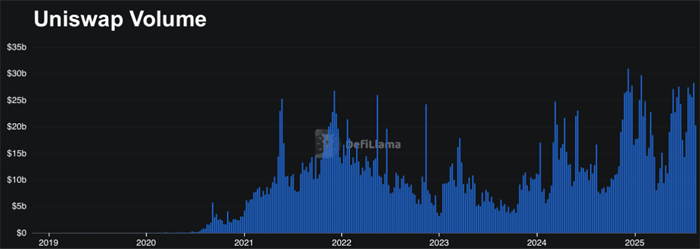Managing Editor’s Note: Before we get into today’s insight from senior crypto analyst Ben Lilly, I wanted to remind you about Jeff’s upcoming Hyper Acceleration event.
We write often in these pages about the technologies that are shaping our future world. And now that we’re reaching the convergence point of many of the biggest technological breakthroughs, a hyper acceleration is coming.
We’ve seen it only a couple of times in history – the Industrial Revolution, the rise of the internet with the dot-com boom – where a convergence of transformative technologies sees massive change and prosperity in a short period.
And right now, we have a short window of opportunity to position ourselves ahead of that prosperity boom.
Jeff’s getting into all the details next Wednesday, August 20, at 8 p.m. ET. You can go here to automatically sign up to attend, then read on for another major shift happening right now, this time in the crypto industry…

The largest decentralized exchange running on the Ethereum blockchain just made a major move…
One that signals how impactful Congress’s current steps are to the crypto industry.
Most folks outside the crypto industry have no idea just how expensive creating a new company can be in the crypto industry. Many think it’s as simple as minting a new token, collecting the cash, and there you go… The reality is far different.
For years, developers and lawyers have had to navigate intricate setups to maintain regulatory compliance.
This meant creating an equity company in one jurisdiction, a foundation in another, and a development “labs” company in yet another.
The intricate web meant costly corporation setups, annual maintenance, tax complications, and filing fees. That’s on top of the costs of keeping a team of lawyers to stay abreast of any changes happening in the various jurisdictions.
And the most difficult challenge was that despite all the expense and effort, many of the crypto projects were still targeted by the SEC in prior years, even without any wrongdoing. And when that happened, it would trigger a wave of legal costs and time spent defending against an antagonistic government.
It was a costly burden. Nobody knew with any certainty how to operate. Law firms made a fortune on the uncertainty.
The byproduct of this era is that investors had limited clarity on what rights they possessed if they bought a token.
Legal clarity and precedents are what make capital markets in the U.S. so attractive. Investors know what they are buying. They know their rights. And even startups have simple templates to spin a new company up to attract capital.
This has never existed for the digital asset industry.
And this is, in part, why Chairman Paul Atkins gave a speech on July 31, where he emphasized how onshoring crypto projects should be the priority.
And since this speech, we’re seeing projects begin to embrace this new policy stance… with one in particular that’s doubling down on its onshoring efforts, reducing costs, and effectively creating more attractive assets for the market.
Uniswap is a decentralized exchange.
It operates as a permissionless protocol where users can swap assets on the blockchain.
Its “permissionless” nature means you don’t need to submit identification or fill out various compliance forms to use it. You can simply interact with the protocol if you choose to do so.
The protocol is fairly simple in design, which is partly why it’s so useful.
It’s on virtually every major blockchain and has the greatest liquidity and the most users in the market.
That means users will get the tightest bid/ask spreads to prevent slippage on their trades. Slippage is the difference between the expected buy or sell price of an asset and the actual price when the trade is executed.
Uniswap’s increased liquidity is all made possible through a series of smart contracts.
Smart contracts are like mini programs that run without needing a middleman or human to approve an interaction. And anybody – or rather, any wallet address – can interact with this smart contract.
This means an individual, a smart contract, or even an agentic AI that manages a wallet can interact with Uniswap. No need to go through another individual or entity to transact on or engage with the protocol, which means faster transactions and less potential slippage.
The Uniswap protocol is managed via a decentralized autonomous organization – DAO for short – that ensures all necessary governance and tax compliance and sits in an entity called the Uniswap Foundation.
It’s not managed by a central entity, which means anybody can participate in the governance project and write proposals that get voted upon, which are then followed through by the foundation.
Think of it as a very open governance structure in which anyone can propose new guidelines and put to a vote any changes to the existing governance, while the foundation is simply there to enable and ensure compliance with those standards.
The problem, however, is that this form of governance has never had any legal clarity. It’s partly why Uniswap Labs – the equity company that helped create Uniswap – was under SEC scrutiny.
The SEC has since dropped its case in recent months.
And in the wake of the SEC speech, the foundation and governance structure are undergoing a major shift.
The Uniswap Foundation is now in the process of creating a new U.S.-based legal entity.
It’s using what’s called the Decentralized Unincorporated Nonprofit Association (DUNA) framework. Uniswap calls the entity DUNI to better align with Uniswap’s native UNI token. And here is the best part… The plans are to register DUNI as a Wyoming-based DUNA, not something registered in Cyprus, Singapore, Switzerland, or some other jurisdiction.
The framework is historic for Uniswap…
Through DUNI, there’s now a legal entity that can retain service providers, enter into contracts, and fulfill regulatory and tax compliance efforts.
It also helps shield those who participate in governance.
But there’s more…
On a decentralized exchange like Uniswap, users can do more than just buy or sell. One unique aspect of these exchanges is that they allow users to contribute coins to a liquidity pool.
In a stock exchange, market makers ensure the orderly trading of stocks and options. These market makers typically make a little bit on each trade and are often established financial firms.
But through decentralized exchanges, anyone can earn market maker commissions by contributing to a liquidity pool.
For years, Uniswap has had what’s referred to as a “fee switch” for its protocol. It’s a line of code that allows the protocol to retain a portion of what is being paid to the users who contribute coins to the liquidity pool.
It’s a contentious issue that’s been put to a vote in governance several times. Users, naturally, hate the fees, but the protocol would be straying into dangerous regulatory waters if they chose to forego them.
The proposal has never been passed, as the token would immediately take on characteristics that would send security officials into a frenzy. That’s because the protocol would be passing this revenue stream to token holders, making it look more and more like a security.
And the revenue from this fee switch is massive.
Uniswap has seen more than $3 trillion of volume since it was created. In the last 30 days alone, it’s seen over $122 billion.

If Uniswap were to initiate a simple 0.05% fee on every trade, that’s $61 million in revenue capture in just the last 30 days.
That’s $732 million annualized.
There are approximately 600 million UNI tokens in circulation, trading at $11 per token. That creates a reward or “yield” of nearly 11.1%.
But here’s the thing…
To earn that reward would require the individual to likely stake the token to the protocol. It’s an action that ties up tokens in circulation. From a supply dynamic, that’s a very good thing for a token. We can think of this as a supply shock. Which means any uptick in demand for the token would create greater price moves to the upside.
But more importantly, it also means not every token would earn those rewards.
Typically, the amount of tokens that get locked up or staked can be as low as 10% or as high as 50%. That means for those that end up staking UNI to the protocol, the reward rate would be multiples higher.
If 25% of UNI gets staked, that implies $4.88 reward for every token or a 44.4% yield.
Legacy finance cannot compete with that. The S&P 500 produces a dividend yield of around 1.25% today.
Layer in the added legal clarity for token holders and how the protocol can operate compliantly, and this is an absolute game-changer.
It’s in part why the CLARITY Act is such a major tailwind for the industry. The bill is expected to be put to a vote in late September. I imagine there will be some debate that pushes it back, but Polymarket pegs the odds at a 52% chance for the bill to be approved this year.
Based upon the push taking place in Washington, D.C., as it pertains to digital assets, I think the actual odds are greater.
Its passage is an immediate catalyst for the market.
And for tokens like Uniswap, this is a major catalyst. More supply will become productive and result in greater demand for holding the token.
There is about to be a major re-pricing for cryptocurrencies coming our way. Uniswap is proof that this is likely to happen sooner than expected.
Your Pulse on Crypto,
Ben Lilly
Senior Crypto Analyst, The Bleeding Edge
The Bleeding Edge is the only free newsletter that delivers daily insights and information from the high-tech world as well as topics and trends relevant to investments.
The Bleeding Edge is the only free newsletter that delivers daily insights and information from the high-tech world as well as topics and trends relevant to investments.